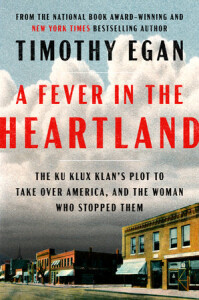
I thought I knew pretty much about the Klan’s history. I knew that it was originally formed in the 1860s by Confederate veterans and tapered out a few years later. I knew that it surged back following the release of the blatantly racist film Birth of a Nation in 1915. But I had no idea how huge it became in the 1920s.
Egan tells a captivating story of D. C. Stephenson, a conman originally from Texas, who appeared in Evansville, Indiana in 1922 and, with no qualifications, set out to take over the state and eventually the White House. How? By appealing to the fears of ordinary white folks, stoking their anxiety about change and blaming their problems on Blacks, Jews, Catholics, and immigrants. The solution, he told them, the way back to that mythical, golden past was to enforce white supremacy.
“These were the people who held their communities together. They were not the criminal element, they were not the psychopaths, sickos and all that.” However, “A vein of hatred was always there for the tapping.”
Stephenson was thoroughly repellent. A cheater and serial rapist who got off on beating up women, his power grew as he quickly rose to the top of the Klan. “Cops, judges, prosecutors, ministers, mayors, newspaper editors—they all answered to the Grand Dragon . . . Most members of the incoming state legislature took orders from the hooded order, as did the majority of the congressional delegation.” Egan says, “The Klan owned the state and Stephenson owned the Klan.”
He became rich by taking a cut of membership dues and other schemes. He bribed pastors to tell their parishioners they must join the Klan. He lied to everyone. “He discovered that if he said something often enough, no matter how untrue, people would believe it. Small lies were for the timid.”
Within two years after his arrival in Evansville, he created a shadow government in the 1924 election. He controlled the General Assembly, the legislature, city halls, courthouses, police departments, and many protestant churches. And he had his army of 400,000 Hoosiers, loyal to the Klan and to Stephenson.
Egan is one of my favorite writers and this book does not disappoint. Vivid writing, solid research and a searing story made it a must-read for me. My only disappointment was that the subtitle—The Ku Klux Klan’s Plot to Take Over America, and the Woman Who Stopped Them—is misleading.
The woman is 28-year-old Madge Oberholtzer, an employee at the Statehouse, who was raped by Stephenson in 1925. More than raped, but I won’t repeat the details here. Her “dying declaration” finally persuaded a jury of White men in a Klan-dominated town to convict Stephenson and send him to prison. Humiliated Klansmen began to quietly pack up their robes.
So, yes, she took down the Klan but not in the derring-do way implied by the subtitle. I wonder if that was the publisher’s work.
If I had read this book before 2016, I would have struggled to believe it. Surely he must be exaggerating, I’d have thought. A few people, of course, but one in three men in a state? How could that many people be so filled with hate, so blindly loyal to such a disgusting man, and so cruel to others? How could so many judges, politicians, ministers be willing to betray their oaths?
Well, Egan doesn’t explicitly draw the parallels with today, but he doesn’t need to.
Now I’ve learned how dependent we humans are on our social tribe and how hard it is to go against them or question their mores. I’ve learned that people don’t want to admit they’ve been wrong—the sunk cost fallacy—or that they’ve been the dupes of a conman. I’ve learned that some churches are out to take over the country and remake it with religious instead of civil rules, just like the Taliban. And greed can outweigh integrity.
Now, I see it happening again. The military-wanna-bes are just sad, but they are only a small part of this wave. I admire the brave journalists, rabbis, and prosecutors who stood up to Stephenson, at great cost. Today we too must stand up to protect democracy here in the U.S. I hope Egan’s book is a great awakening.
Have you read any historical nonfiction that has helped you understand today’s plots to take over the U.S.?